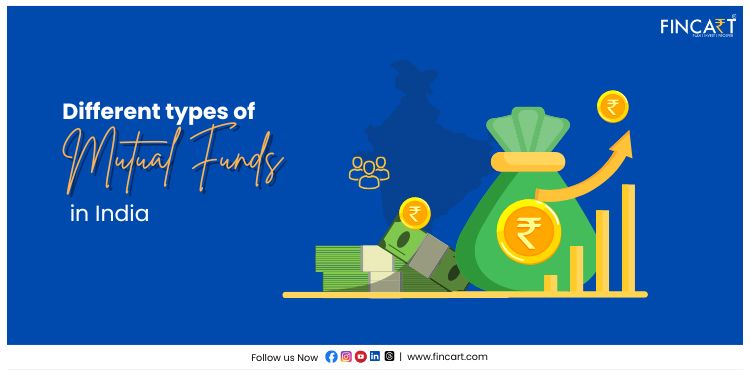In recent years, mutual funds have emerged as a popular option for investors thanks to many benefits such as diversification, professional management, liquidity, convenience, and variety. However, because of the different types of mutual funds available in the market, new investors can find it challenging to choose the right fund for their needs. So let’s take a look at the features and benefits of various types of mutual funds in India, so you can select the ones that suit you the best!
Types of Mutual Funds in India
We can divide different types of mutual funds based on various factors such as the primary asset class they invest in, investment objectives, mutual fund structure, specialised categories, and risk profile.
Types of Mutual Funds Based on Asset Class
The main asset classes include equities (stocks), fixed income (debt instruments), and a mix of both, called hybrid or balanced funds. Based on how much allocation the fund manager gives to each asset class, mutual funds can be categorised as follows:
1. Equity Mutual Funds
As the name suggests, equity mutual funds primarily invest in equities, i.e., stocks of different companies. SEBI (Securities and Exchange Board of India) guidelines indicate that to be classified as an equity mutual fund, at least 65% of the fund’s portfolio must be invested in equities. Because the investment is mainly made in shares, the risk associated with equity mutual funds is also high. This makes them suitable for individuals with a high-risk tolerance and a long-term investment horizon. However with high risk comes high reward, as equity mutual funds have the potential to deliver very high returns over time.
According to SEBI regulations, equity mutual funds are categorised into 11 sub-categories. Each sub-category has different characteristics and investment strategies associated with them. Here’s a quick look at each sub-category:
- Large-Cap Funds – Large cap means the companies ranked in the top 100 by market capitalization. Large-cap funds invest a minimum of 80% of their total assets in large-cap stocks.
- Mid-Cap Funds – Mid-cap companies rank from 101 to 250 in terms of market capitalization. These funds allocate at least 65% of their assets to mid-cap stocks.
- Small-Cap Funds -These funds invest a minimum of 65% of their assets in small-cap stocks, meaning the companies beyond the top 250 by market capitalization.
- Multi-Cap Funds – These funds invest in different large-cap, mid-cap, and small-cap companies, with a minimum of 65% in equities. Multi-cap funds are more diversified than the above three categories.
- Large and Mid-Cap Funds – These funds allocate at least 35% in large-cap, and 35% in mid-cap companies.
- Dividend Yield Funds – Dividend yield shows how much a company pays out in dividends. These funds invest at least 65% of their assets in companies that have a high dividend yield.
- Value Funds – Funds where the fund manager uses the value investment strategy are called value funds. The manager invests at least 65% of the fund’s assets in undervalued stocks.
- Contra Funds – In these funds, the manager adopts a contrarian investment strategy, and invests at least 65% of the fund’s assets in stocks that are currently out of favour but can have the potential to recover and grow. A fund can be either value-focused or contra-focused.
- Focused Funds – These funds are only allowed to invest in a maximum of 30 stocks, with at least 65% of their assets in equities.
- Sectoral/Thematic Funds – In these types of equity funds, investment is done in a specific sector or theme, such as healthcare, technology, or infrastructure. At least 80% of the assets are invested in a specific theme or sector.
- ELSS (Equity Linked Savings Scheme) – These are also called tax-saving funds as they offer tax benefits up to Rs. 1.5 lakh under Section 80C of the Income Tax Act.
Also Read: Understanding ELSS Funds: Definition and How They Work
2. Debt Mutual Funds
Debt mutual funds invest mainly in fixed income assets such as government bonds, corporate bonds, treasury bills, and commercial papers. These types of mutual funds are more suitable for investors with a low risk tolerance, and those who want to first and foremost protect the value of their capital. That’s why the returns associated with these funds are more stable and predictable but tend to be lower compared to equity funds. SEBI has categorised these funds into 16 subcategories. Here are some of them:
- Liquid Funds – These funds invest in very short-term instruments with a maturity of only 91 days. They offer investors high liquidity and low risk.
- Overnight Funds – Investment is made in very short-term securities like government and corporate debt instruments that have a maturity of 1 day.
- Money Market Funds – Managers invest in treasury bills, commercial papers, and certificates of deposit that mature in one year.
- Banking and PSU Funds – A minimum of 80% of assets are invested in debt securities issued by banks, Public Sector Undertakings (PSUs), and Public Financial Institutions.
- Floater Funds – 65% of the fund’s assets are invested in floating rate instruments.
3. Hybrid Mutual Funds
While equity mutual funds offer high returns along with high risk, and debt mutual funds provide lower returns with reduced risk, hybrid funds try to strike a balance between the two. These mutual funds are also thus called balanced funds, and they invest in a mix of debt and equity instruments. Hybrid funds are good for investors with moderate risk profiles, looking for a bit of exposure to equity for earning better returns. SEBI has categorised hybrid funds into seven types:
- Aggressive Hybrid Funds – These funds are equity-oriented, so they invest 65% to 80% of the fund’s total assets in equities and 20% to 35% in fixed-income securities.
- Conservative Hybrid Funds – These funds are debt-oriented, meaning fixed-income instruments get a larger allocation compared to equities. 75% to 90% of the fund’s assets are invested in debt instruments, whereas a smaller portion is invested in equities.
- Balanced Hybrid Funds – 40% to 60% of the fund’s assets are invested in both equity and debt instruments. The main goal is to strike as close to a 50-50 balance between equities and fixed-income securities as possible.
- Dynamic Asset Allocation Funds or Balanced Advantage Funds – The asset allocation between equities and debt is dynamic, which means the exposure to equities depends on market conditions.
- Arbitrage Funds – These funds follow the arbitrage investment strategy, and a minimum of 65% of the fund’s total assets are invested in equity instruments.
- Multi-Asset Allocation Funds – These funds invest in at least three different asset classes such as equities, fixed income, commodities, and foreign investments, with at least 10% of their assets to each asset class.
- Equity Savings Funds – These funds allocate a minimum of 65% of their total assets in equities and equity-related instruments and at least 10% in debt instruments. The specifics of minimum hedged and unhedged allocations are given in the scheme information document.
Types of Mutual Funds Based on Investment Objectives
Investors have different financial goals when they invest. Some want to grow their money to pay for things like their child’s education or buying a home. Others look to preserve their money and earn a steady income. Some invest to build wealth and save on taxes, while others invest for a peaceful retirement. Different types of mutual funds help achieve different financial goals:
1. Growth Funds
Growth funds invest mainly in equities, specifically shares of companies that have high growth potential. Those who invest in growth funds do so with the aim of capital appreciation, that is, building wealth over a long period.
2. Income Funds
Income funds are low-risk as they invest in fixed-income securities like bonds and dividend yielding stocks. These funds provide a steady and predictable income, so they are ideal for conservative investors seeking a steady stream of income with lower risk, such as retirees.
3. Balanced Funds
Since balanced funds invest in a mix of equity and debt instruments, they are suitable for investors with a moderate risk appetite.
4. Tax-Saving Funds
Tax-saver funds, also called Equity Linked Savings Schemes (ELSS), can help investors reduce their taxable income by Rs. 1.5 lakh under Section 80C of the Income Tax Act. These funds come with a lock-in period of 3 years, and since they mostly invest in equity instruments, they also offer very attractive returns. They are suitable for investors with a high-risk appetite and a long-term investment horizon looking to create wealth while saving on tax.
5. Pension Funds
Pension funds can help investors build a corpus for retirement by investing in a mix of equities and debt instruments.
Also Read: How Mutual Funds Provides More Returns Than Real Estate Investment?
Types of Mutual Funds Based on Structure
Based on the maturity period and how investors buy and sell units, mutual funds can be categorised as open-ended, close-ended, or interval funds.
1. Open-Ended Mutual Funds
Individuals who invest in open-ended funds do not have to worry about a specific maturity date or being locked into their investment as they do not have a fixed maturity. One is allowed to buy or sell shares at the fund’s net asset value (NAV) at any time, which offers investors high liquidity. Due to the flexible entry and exit points, these funds are a popular option among investors, and most of the funds in the market today are open-ended.
2. Close-Ended Mutual Funds
Unlike open-ended funds, closed-ended funds have a fixed maturity period. This means that investors can buy units only during the initial period, also called the New Fund Offer (NFO). After the initial offer ends, the units can be traded on stock exchanges, just like shares. Due to this low liquidity, these funds should be only considered for mid to long investment periods.
3. Interval Funds
Interval funds strike a balance between open-ended and close-ended funds by allowing investors to buy or sell units at specific intervals. Simply put, these are like close-ended funds, but investors are given periodic opportunities for buying or selling.
Types of Mutual Funds Based on Specialized Categories
1. Index Funds
These funds use a passive investment strategy by trying to replicate the performance of a specific index, such as the Nifty 50. They invest in the same stocks and in the same proportions as the index. This way, the fund’s performance closely tracks the index’s performance. Since these funds are not actively managed, they have lower fees compared to other funds.
2. Exchange-Traded Funds (ETFs)
ETFs are like a mix of stocks and index mutual funds. When you buy a stock, you only invest in a single company. But when you buy an ETF, you invest in a collection of stocks or other assets which gives you the benefit of diversification across many companies or assets with a single purchase. And just like stocks, ETFs can be traded on stock exchanges.
3. Sectoral Funds
Sector funds invest at least 80% of the fund’s assets in a specific sector, like technology or pharma. The fund manager analyses the performance and trends of various sectors and selects the one they believe will perform the best. The fund manager then selects different companies within the sector and invests in them. These funds have a very high growth potential, but they also come with significant risk because if the chosen sector underperforms, the fund’s value can decline sharply due to the lack of diversification outside the sector.
4. Thematic Funds
In these funds, managers pick a theme and invest in shares that are connected to it. For example, an infrastructure-themed fund may invest in companies involved in building and maintaining infrastructure, like steel manufacturers, cement companies, construction firms, power suppliers, and so on.
Types of Mutual Funds Based on Risk Profile and Return Potential
Since mutual funds are a market-linked product, they are subject to different types of risk such as market risk, credit risk, and interest rate risk. According to SEBI guidelines, every mutual fund scheme is required to display a risk-o-metre in its scheme information document. This risk-o-metre gives investors a visual representation of the risk level associated with the fund.
1. Low-Risk Funds
The majority of this fund’s assets are invested in debt instruments with short maturity periods, which makes low-risk funds suitable for conservative investors with a short investment horizon. Some examples of low-risk funds are liquid funds and overnight funds.
2. Medium-Risk Funds
These types of funds are suitable for investors looking for stability but still desire some exposure to equities for wealth creation. They offer a balanced approach by combining the lower risk of fixed-income securities with the growth potential of equities. Examples of medium-risk funds include balanced advantaged funds and multi-asset funds.
3. High-Risk Funds
High-risk funds invest primarily in high-risk securities such as equities. Investors should always invest in such funds with the long-term in mind because then they are more likely to ride out the short-term market fluctuations and benefit from the higher returns that equity offers. For example, ELSS and small-cap funds are considered high-risk mutual funds.
Professional Guidance for Choosing the Best Mutual Fund
As you can see, there are many different types of mutual funds available that cater to a variety of investors. Once you’ve thoroughly assessed your financial situation, goals, and risk appetite, you can decide which kind of mutual fund would be best for your needs. After that, you’ll have to sift through the various schemes offered by different Asset Management Companies (AMCs) within the same category of fund. For example, if you determine that a balanced advantage fund would align the best with your current needs, next you’ll have to evaluate and compare different balanced advantage funds based on a vast number of factors such as history, fund manager expertise, performance ratios, fees, expense ratios, etc.
This entire process can seem intimidating, which is why it could be wise to consult with a mutual fund advisor before investing. An advisor can assess your financial situation, goals, and risk tolerance to build a comprehensive risk profile. They can then recommend suitable mutual fund options that align with your risk profile and investment goals. They inform you about the tax implications of your investments and even monitor the performance of your portfolio to recommend timely adjustments to keep your portfolio aligned with your goals.
Conclusion
Whether you’re a young investor aiming to build wealth, someone seeking to preserve the value of your money, or a retiree looking for a steady income, you’ll find there’s a mutual fund that suits your needs. Knowing about these different types of mutual funds will help you make more informed decisions.
FAQs
How many types of mutual funds
There are many types of mutual funds, which are essentially categorised based on criteria such as the asset class they mainly invest in, risk profile, investment goals, mutual fund structure, and other factors.
What are the four types of mutual funds?
The four main types of mutual funds are debt funds, equity funds, hybrid funds, and solution-oriented funds.
What are the three general types of mutual funds?
The three general types of mutual funds are equity funds, debt funds, and hybrid funds.
Which mutual fund type is best?
The best mutual fund is the one that aligns with your risk profile, financial goals, and investment horizon. For example, if you have a high-risk tolerance and a long-term investment horizon, you can consider investing in equity mutual funds. If you are looking for tax-saving investment options, you can consider investing in Equity Linked Savings Schemes (ELSS), which offer tax benefits under Section 80C.




